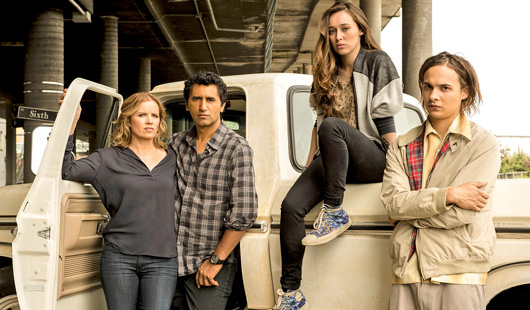
After a six-episode run, the truncated first season of Fear the Walking Dead, the spinoff of The Walking Dead, came to a close with its finale on Oct. 4. The show, which tells the story of a family during the onset of a zombie apocalypse, plays with the idea of slowly pulling the audience into this catastrophe, so that we can see it all happen from the very beginning, through the characters’ eyes. But Fear fails to deliver on that point, and on so many others.
Where its parent show began after the world had already ended, so to speak, Fear promises to show us just how it all went down, but ends up rushing headlong into the thick of things when it should have been slowing information to a snail’s pace, leaving the viewer wondering and biding its time. The result was that the season finale left its characters in the exact same situation as those on The Walking Dead, because the cataclysm took a mere handful of episodes to happen. What little this series had to distinguish itself, it lost when the characters high-tailed it out of the burning, walker-infested Los Angeles, removing the “fear of the unknown” element that one thought might define the series.
While the slipshod approach to this serialized fall of humanity is agonizing enough, the logistics of the whole affair, and how they were mishandled, are downright insulting. Fear is set in Los Angeles, in which there are 10.2 million people. Are we truly expected to believe that the entire city succumbs to this plague over the course of six episodes? Particularly when, during the second episode, LA remained civilized and whole, aside from just a few zombies and one riot. Presumably, this show is going for semi-realism, so that, apart from the undead, we aren’t expected to suspend our disbelief all that much. A quick collapse of civilization might be plausible . . . but not this quick.
Moreover, as a series that serves as a prequel to The Walking Dead, and which documents the downfall of society – even if from the perspective of a core group of people – don’t the showrunners have a responsibility to have an eye for detail? How, for example, does this outbreak affect agriculture? How does it affect the media? Even after TV, internet, etc. goes down, shouldn’t we be seeing now-precious footage saved on hard drives, flash drives, and video cameras? It would offer us a glimpse of what’s happening without shoving it right under our noses, and through a variety of mediums, no less. It would have been innovative, and much better at instilling discomfort in the viewer than the jump scares the story has relied upon so far. But we have already seen that this is a show that does not understand subtlety. A plot that begins as a trickle becomes a deluge much too soon, and believablity gets washed away.
Strangely enough, this show shined brightest during its first few episodes (and you might remember my critical review of those installments in a previous article). But it’s not all bad. The class discussion of Jack London’s short story To Build a Fire spoke volumes about what moral and existential questions the series was hoping to pose, as did other scattered indicators, like a teacher lecturing students on “chaos theory.” But all that quickly melted away when the proverbial sh*t hit the fan too soon, and both allegory and context became as uneven as the episodes that followed.
One might hope, at least, that the stars of the show could carry it through lackluster writing, but there’s failure even in that department. Truthfully, the characters are not all that compelling. Madison is subdued and forgettable. Nick, as a recovering drug addict, certainly seems like an interesting idea on paper, but perhaps due to the sarcastic, deadbeat tone of the character, fails to captivate my empathy or interest. Travis, the father and moral center who is struggling to hold on to his compass, remains the most interesting character, as does Daniel, a barber and El Salvadoran refugee who, on the other hand, has no qualms about doing what is necessary to survive. Daughter Alicia is also interesting, mostly because the writers don’t let viewers get inside that character’s headspace very often.
But there’s still room for creativity. Having the ensemble leave LA and board a yacht, escaping (as far as they know) on the open sea, is a promising scenario, one that could put some much needed distance between The Walking Dead‘s rural, post-armageddon-Americana landscape and this one. Fear could go west – to Hawaii, perhaps? It could even go international, which would really be something.
So far, however, with the apparent lack of storytelling initiative, one can’t help but wonder if this prequel was merely meant as a “zombie money” generator for AMC while The Walking Dead, their main cash cow, was on hiatus. As of right now, it feels like Fear has jumped the shark before it could put more than a single toe in the water.
If we, the viewers, are expected to come back for more, we need assurances that Fear is not simply meandering along the same path as its predecessor, giving us the same character archetypes, except with different names and beneath a different-colored spotlight; the same dilemmas and mantras about “surviving” and “doing what’s necessary” with little to no variation . . . or reason for us to even care.
Photo: Fear the Walking Dead/AMC









